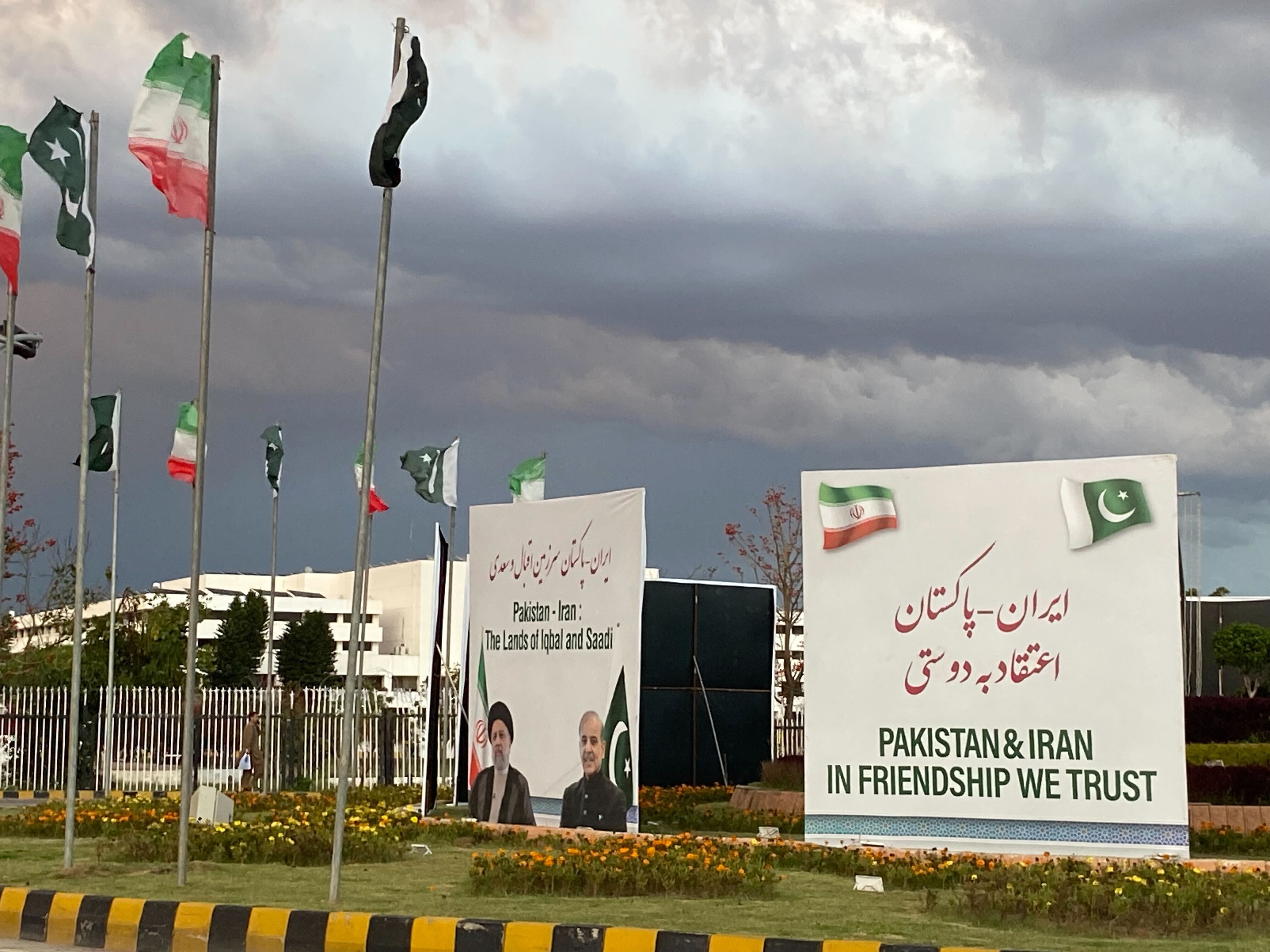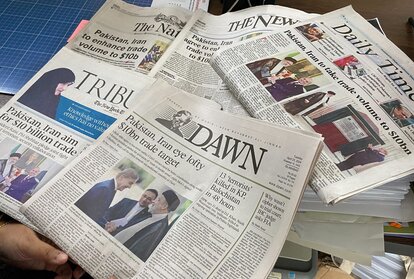Alumni Voices
A review of Iranian President's trip to Pakistan

Banners in the D-Chowk in front of Parliament House, Iranian President Ebrahim Raisi's trip to Pakistan - April 2024,Islamabad
© Birgit LammIranian President Ebrahim Raisi's visit to Pakistan was a case study in “what could be.” As the first such visit by an Iranian leader to Pakistan in eight years, it marked a significant development in bilateral relations. It was rendered that much more important amid bilateral tensions triggered by a missile exchange by both sides in January and broader regional conflicts such as the Israel-Gaza issue and Iran's attack on Israel for targeting its Damascus consulate.
Raisi engaged with federal and provincial Pakistani officials, and was given the red-carpet treatment wherever he went. However, the welcome by a housing minister at his arrival, instead of the prime minister, could be seen as an omen of how much actual importance his visit was given.
The January missile exchange begun with Iran targeting Jaish al Adl militants and Pakistan retaliating against Baloch Liberation Front and Baloch Liberation Army bases. Both regions, Balochistan in Pakistan and Sistan-Baluchestan in Iran, are known for their mineral wealth, underdevelopment, and militancy. This did no favours for Iran at a time when it needs more positive engagement with its neighbours.
Key discussion points between Pakistan and Iran
- Focus on Security Cooperation: Security cooperation was a key focus of the trip, given concerns about cross-border terrorism and drug trafficking. Both countries must improve currently-lax border security, which allows violence, drugs, and weapons to flow. They have pledged to combat terrorism and establish a consultation system at the foreign minister level, highlighting an important step forward.
- The Peace Pipeline Project: Another key point of discussion was the Iran-Pakistan gas pipeline project, known as the Peace Pipeline. Pakistan claims it is committed to completing the project signed in 2010, for which Iran has long-built its side of the pipeline. Tehran has repeatedly expressed its annoyance, legitimately, for Pakistan having promised, but not delivered on constructing its end of the pipeline.
- Challenges and US Sanctions: Islamabad says it plans to seek a waiver from Washington to construct the pipeline on its territory. However, the US State Department threw cold water on that notion, warning Pakistan about the risk of sanctions for doing business with Iran. Pakistan has few options to work around this.
- Economic Benefits and Political Implications: The completion of the pipeline would benefit both countries, but in different ways. It would provide a badly-needed, overdue, and reliable gas source for an energy-hungry Pakistan. For Iran, it would be the ultimate win, proving its economic and political prowess in the region. If activated, the project would also be an unprecedented move of political courage and determination by Pakistan to uphold its national interests despite external pressure.
- Trade and Economic Cooperation : Beyond the pipeline, Iran and Pakistan aim to grow their current $2 billion annual trade to $10 billion. They will also expedite the Free Trade Agreement (FTA) and enhance connectivity, infrastructure, and energy cooperation as members of the Belt and Road Initiative (BRI) and the Economic Cooperation Organization (ECO).
- Military and Strategic Coordination: A meeting between Pakistan’s Chief of Army Staff (COAS) and Raisi, according to an army read-out, focused on regional peace, stability, and border security, emphasising improved coordination to prevent jeopardising relations.
The Iranian president’s visit underscores the importance of dialogue and collaboration for peace, but also requires a step back and a sprinkle of realism on both sides about what the other can actually achieve.

Newspaper Headlines about Iran's President Visit to Pakistan , 23rd April 2024
© Birgit LammAgreements and Joint Statement
Raisi's visit resulted in eight Memorandum of Understandings (MoUs) signed in areas like security and the economy, with both nations committing to combat terrorism. The trip culminated with a joint statement expressing a desire to bolster historical, cultural, religious, and “civilisational” ties. Emphasising sovereignty and territorial integrity, the statement stresses peaceful dispute resolution, reaffirming a commitment to peacefully resolving the Kashmir issue. Recognising their common border as a “border of peace and friendship,” Pakistan and Iran say they aim to transform it into a “border of prosperity.”
Economic Challenges and Diplomatic Balancing
On regional tensions, despite Pakistan's lack of diplomatic ties with Israel and its criticism of Israeli actions in Gaza, both Islamabad and Tehran find themselves affiliated with different, and often opposing regional factions, further complicating their individual and mutual diplomatic and military strategies.
Grappling with economic crises, Pakistan needs the financial support of Saudi Arabia, the United Arab Emirates, and the United States—each a rival of Iran, and none of whom Islamabad wishes to anger. PM Shehbaz Sharif's recent trip to Saudi Arabia underscored this reality. Maintaining a delicate balance between relations with Iran and the US is, as any Pakistani official will admit, both vital and difficult as Islamabad expands its trade and energy partnerships with Tehran, especially given US sanctions and Pakistan's reliance on Western aid.
All in all, Raisi's visit was a significant strategic move for Tehran, representing a challenge to Iran’s perceived isolation and US sanctions. His visit aimed to navigate complex geopolitical realities by enhancing ties, addressing regional issues, promoting cultural exchanges, and expanding Tehran’s regional engagement. Navigating the complexities of the Middle East, with ongoing conflicts and shifting alliances, requires careful consideration of national interests by both Iran and Pakistan to achieve stability. The Iranian president’s visit underscores the importance of dialogue and collaboration for peace, but also requires a step back and a sprinkle of realism on both sides about what the other can actually achieve.
Call for Action and Independent Path
Pakistan must prioritise its national interests in the face of external pressures, adopting strategies that align with its needs for stability and prosperity. Its leaders will need to chart an independent path forward, in which tough decisions will need to be made, and political courage will be the only path ahead. In the absence of that, Islamabad will always find itself being pushed from influence by one alliance or another, without breaking out of this vicious cycle.
'Alumni Voices' is a series of articles written by Pakistani professionals from different walks of life on their perspective on current affairs of the country. The views expressed in this article do not necessarily represent the views of the Friedrich Naumann Foundation for Freedom.
